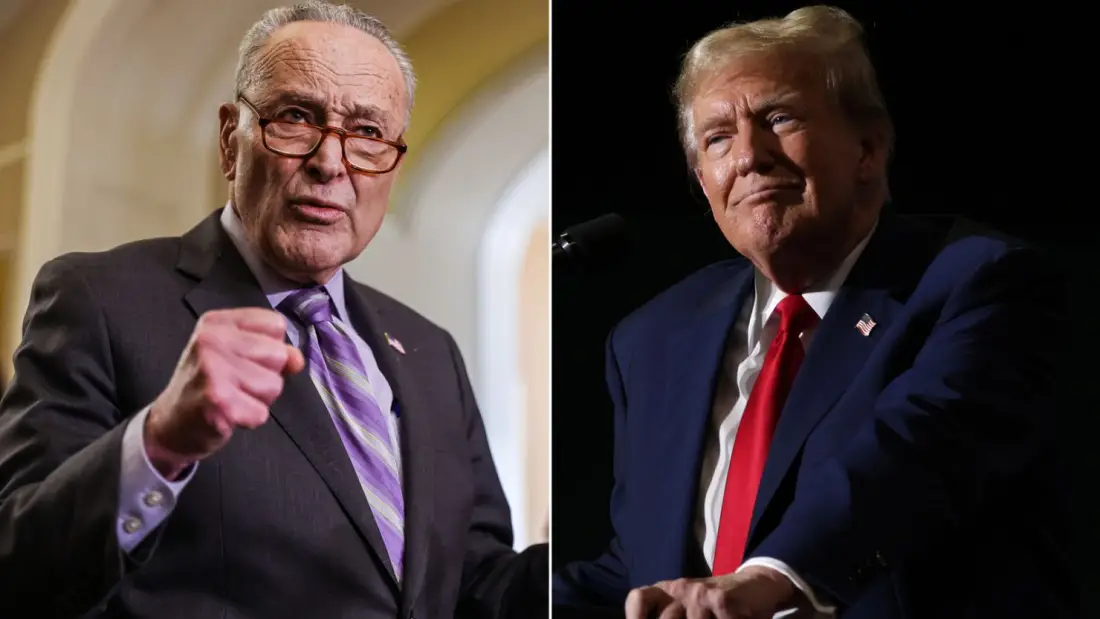The lights were still on inside the West Wing long after midnight.
Phones buzzed, aides rushed down the marble hallways, and one message echoed through Washington: time was running out.
At 12:01 a.m. on Wednesday, the United States government could grind to a halt.
And according to White House Press Secretary Karoline Leavitt, that shutdown might come with a devastating cost — mass layoffs across federal agencies, affecting tens of thousands of American workers.
The warning, delivered in a tense press briefing, marked one of the starkest moments yet in the escalating standoff between President Donald Trump’s administration and congressional Democrats.
“There will be layoffs if Democrats don’t keep the government open,” Leavitt said, her voice firm.
“We are nearing a government shutdown. The president wants to meet the deadline. He wants to keep this government open.”
Her words landed like thunder in Washington — part warning, part accusation, and part rallying cry.
A Crisis in Slow Motion
The fight over government funding had been brewing for weeks, quietly but relentlessly.
Behind closed doors, negotiators from both parties tried to reach an agreement to extend funding past September 30.
The Republican-led House had already passed a stopgap bill — a “clean” continuing resolution, known on Capitol Hill as H.R. 5371.
It was a short-term measure meant to keep the lights on until November 21, giving lawmakers time to finalize a long-term spending package.
But in the Senate, the bill stalled.
Democrats refused to advance it without adding a series of new provisions — including expanded health care funding, climate initiatives, and immigration policy changes that the White House called “radical and reckless.”
“We’re not asking for the world,” Leavitt said. “All we want is a commonsense, clean funding resolution. Democrats are holding it hostage to demand $1 trillion in new spending — spending the American people don’t want, and can’t afford.”
The impasse left the federal government hanging by a thread — and millions of Americans wondering what would happen if that thread snapped.
Behind the Scenes at the White House
By Tuesday afternoon, the atmosphere inside the West Wing had shifted from tension to urgency.
The Office of Management and Budget (OMB) quietly circulated a memo to all federal departments — a document that read more like a doomsday plan than a policy directive.
The message was blunt: prepare for layoffs.
“With respect to those federal programs whose funding would lapse,” the OMB memo read, “such programs are no longer statutorily required to be carried out. RIF notices should be issued to all employees tied to those programs.”
“RIF” — short for “Reduction in Force” — is bureaucratic language for mass job cuts.
For tens of thousands of federal workers, it meant uncertainty.
In the corridors of Washington’s massive office complexes, whispers began to spread.
Would their paychecks arrive next week? Would their jobs still exist by Friday?
At agencies from Homeland Security to the Department of Agriculture, contingency plans were activated.
Non-essential staff were told to be ready for furlough.
Federal contractors were warned that payments might be delayed.
“We’ve been through shutdowns before,” one longtime Department of Commerce employee said. “But this one feels different. This time, nobody’s sure who’s actually trying to stop it.”
The Blame Game
Both sides blamed the other — and both were digging in.
Democrats accused Trump of using the threat of a shutdown to force spending cuts and advance his immigration agenda.
Republicans countered that Democrats were playing politics, deliberately sabotaging a bipartisan process to score points before next year’s midterms.
“The president is giving Democrat leadership one last chance to be reasonable,” Leavitt said. “Now is not the time to try to get political points against Donald Trump.”
For her part, House Minority Leader Hakeem Jeffries accused the administration of “holding the country hostage.”
“They’re manufacturing this crisis,” Jeffries told reporters. “We’re not going to sign off on a deal that cuts health care and attacks working families.”
The White House fired back, pointing to what it called “unrealistic and dangerous demands.”
Democrats had proposed more than a trillion dollars in new spending, much of it focused on social programs and expanded coverage for undocumented immigrants — a proposal Trump immediately rejected.
“We will not spend taxpayer money giving health care to illegal migrants while Americans can’t afford their own bills,” Leavitt said.
“We’ve Been Warning About This”
Inside the White House, aides say the administration had been preparing for this showdown since midsummer.
When Trump returned to office in January, one of his first directives was to shrink the federal bureaucracy, launching a sweeping efficiency plan that included buyouts, hiring freezes, and the elimination of redundant programs.
The effort reduced the federal workforce by thousands — but this crisis, they warned, could force far deeper cuts.
“We’ve been warning about this,” one senior White House official said. “The president’s goal has always been to streamline government responsibly. But if Democrats push this to a shutdown, we’ll have no choice but to take drastic measures.”
Those measures, the official said, could include permanent layoffs across dozens of departments.
In effect, the very shutdown Democrats were trying to use as leverage could end up accelerating Trump’s long-term plan to downsize Washington.
The Ripple Effect
The uncertainty is rippling far beyond the Beltway.
In the financial markets, investors are watching nervously.
A government shutdown doesn’t just freeze paychecks — it shakes confidence.
In previous shutdowns, agencies like the FDA halted food safety inspections, the State Department delayed passports, and the IRS suspended refunds.
National parks and museums went dark.
This time, with the economy still adjusting after inflation shocks and interest rate hikes, analysts warn that a shutdown could send shockwaves through Wall Street.
At the same time, small towns across America — particularly those near military bases or government hubs — could feel the sting first.
Federal contractors, many of whom operate on thin margins, might be forced to lay off workers or shutter entirely if the funding lapse continues beyond a week.
Democrats Dig In
Meanwhile, Democrats appear unwilling to compromise.
On Tuesday, Senate Majority Whip Dick Durbin insisted that any funding bill must include provisions for “expanded access to health care, environmental protection, and social equity.”
Progressives, including members of the so-called “Squad,” called Trump’s clean continuing resolution “a sham.”
“We’re not going to fund cruelty,” Rep. Ilhan Omar (D-Minn.) said. “We’re not going to rubber-stamp a Trump budget that abandons working people.”
But even some moderate Democrats expressed frustration privately, saying party leaders were ignoring the political reality.
“Nobody wins in a shutdown,” one Democratic senator told The Hill. “And right now, it looks like we’re walking straight into one.”
Inside the Administration’s Strategy
Behind the scenes, Trump’s team believes they hold the upper hand.
Their argument is simple: the Republican-led House already did its job.
The Senate Democrats — and especially Schumer and Jeffries — are the ones standing in the way.
“This is not a political stunt,” one administration aide said. “The president wants to keep the government open. The Democrats want to use it as leverage.”
In private meetings, Trump reportedly told his Cabinet that Democrats “don’t care about workers — they care about headlines.”
According to one senior official, Trump sees this fight not just as a budget issue, but as a test of who controls Washington.
“This isn’t just about spending,” the aide said. “It’s about power — and who’s actually running the government.”
Preparing for Impact
At federal agencies, the reality is setting in.
Some employees have begun packing personal items, fearing that furloughs could last weeks.
Human resources departments are quietly distributing Reduction in Force (RIF) guidelines, outlining how layoffs would proceed if funding lapses.
The mood is anxious.
“We’ve had shutdown scares before,” one Department of Transportation staffer said. “But usually, you feel like Congress will pull it together at the last second. This time… it doesn’t feel that way.”
Even the Pentagon is preparing for disruptions, with Defense Department officials confirming that civilian employees could be among the first affected.
If the shutdown hits, active-duty service members would continue to report for duty — but many would go without pay until funding resumes.
Trump’s Message: “We’re Ready”
Despite the rising tension, the White House is projecting calm — and confidence.
“We’re ready for whatever happens,” Trump reportedly told aides during a late-night strategy session. “But the American people deserve better than political games.”
In public, Leavitt has remained the administration’s sharpest voice, warning Democrats that the consequences of inaction will be on their shoulders.
“We remain hopeful Democrats will not trigger a shutdown,” she said. “But agencies must prepare for all outcomes.”
She closed the briefing with a single sentence that summed up the stakes:
“The clock is ticking.”
The Human Cost
While Washington argues, families across the country brace for impact.
From park rangers in Montana to IRS analysts in Ohio, federal employees are living in limbo — refreshing news alerts and waiting for answers that may not come in time.
“You try to focus on your work,” said one furlough-prone NASA engineer, “but it’s hard not to think about the mortgage, or the kids, or the fact that all of this is happening because people in Congress can’t compromise.”
If a shutdown does occur, experts estimate that over 800,000 federal workers could miss paychecks — many living paycheck-to-paycheck themselves.
And while political leaders debate over billion-dollar policy packages, those workers are wondering how they’ll pay for groceries.
A Dangerous Game
As the deadline looms, one thing is clear: both sides are gambling — but the stakes couldn’t be higher.
Trump and his allies believe that voters will blame Democrats for the chaos.
Democrats, meanwhile, are betting that voters will turn on Trump for “manufacturing” the crisis.
But beyond the talking points and headlines, the truth is simpler — and harsher.
America is once again staring down a self-inflicted wound.
And this time, the consequences may go far beyond politics.
“This isn’t just a shutdown,” one Washington veteran said quietly. “It’s a test of who’s still capable of governing this country.”
The clock keeps ticking.
The deadline keeps creeping closer.
And somewhere inside the White House, the lights are still on — glowing gold in the darkness, as Washington holds its breath.

Ethan Blake is a skilled Creative Content Specialist with a talent for crafting engaging and thought-provoking narratives. With a strong background in storytelling and digital content creation, Ethan brings a unique perspective to his role at TheArchivists, where he curates and produces captivating content for a global audience.
Ethan holds a degree in Communications from Zurich University, where he developed his expertise in storytelling, media strategy, and audience engagement. Known for his ability to blend creativity with analytical precision, he excels at creating content that not only entertains but also connects deeply with readers.
At TheArchivists, Ethan specializes in uncovering compelling stories that reflect a wide range of human experiences. His work is celebrated for its authenticity, creativity, and ability to spark meaningful conversations, earning him recognition among peers and readers alike.
Passionate about the art of storytelling, Ethan enjoys exploring themes of culture, history, and personal growth, aiming to inspire and inform with every piece he creates. Dedicated to making a lasting impact, Ethan continues to push boundaries in the ever-evolving world of digital content.
